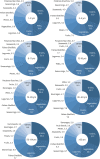Magnesium intake and dietary sources among Koreans: findings from the Korea National Health and Nutrition Examination Survey 2016-2019
- PMID: 36777797
- PMCID: PMC9884591
- DOI: 10.4162/nrp.2023.17.1.48
Magnesium intake and dietary sources among Koreans: findings from the Korea National Health and Nutrition Examination Survey 2016-2019
Abstract
Background/objectives: Magnesium is an essential nutrient for human health. However, inadequate intake is commonly reported worldwide. Along with reduced consumption of vegetables and fruits and increased consumption of refined or processed foods, inadequate magnesium intake is increasingly reported as a serious problem. This study aimed to assess magnesium intake, its dietary sources, and the adequacy of magnesium intake in Korean populations.
Subjects/methods: Data was obtained from the Korea National Health and Nutrition Examination Survey 2016-2019 and included individuals aged ≥1 yr who had participated in a nutrition survey (n=28,418). Dietary intake was assessed by 24-h recall, and dietary magnesium intake was estimated using a newly established magnesium database. Diet adequacy was evaluated by comparing dietary intake with the estimated average requirement (EAR) suggested in the Korean Dietary Reference Intakes 2020.
Results: The mean dietary magnesium intake of Koreans aged ≥1 yr was 300.4 mg/d, which was equivalent to 119.8% of the EAR. The prevalence of individuals whose magnesium intake met the EAR was 56.8%. Inadequate intake was observed more in females, adolescents and young adults aged 12-29 yrs, elders aged ≥65 yrs, and individuals with low income. About four-fifths of the daily magnesium came from plant-based foods, and the major food groups contributing to magnesium intake were grains (28.3%), vegetables (17.6%), and meats (8.4%). The top 5 individual foods that contributed to magnesium intake were rice, Baechu (Korean cabbage) kimchi, tofu, pork, and milk. However, the contribution of plant foods and individual contributing food items differed slightly by sex and age groups.
Conclusions: This study found that the mean dietary magnesium intake among Koreans was above the recommended intake, whereas nearly one in 2 Koreans had inadequate magnesium intake. To better understand the status of magnesium intake, further research is required, which includes the intake of dietary supplements.
Keywords: Magnesium; NHANES; Republic of Korea; dietary intake.
©2023 The Korean Nutrition Society and the Korean Society of Community Nutrition.
Conflict of interest statement
Conflict of Interest: The authors declare no potential conflicts of interest.
Figures


Similar articles
-
Dietary zinc intake and sources among Koreans: findings from the Korea National Health and Nutrition Examination Survey 2016-2019.Nutr Res Pract. 2023 Apr;17(2):257-268. doi: 10.4162/nrp.2023.17.2.257. Epub 2023 Jan 10. Nutr Res Pract. 2023. PMID: 37009146 Free PMC article.
-
Dietary intake and major source foods of vitamin E among Koreans: findings of the Korea National Health and Nutrition Examination Survey 2016-2019.Nutr Res Pract. 2022 Oct;16(5):616-627. doi: 10.4162/nrp.2022.16.5.616. Epub 2021 Dec 28. Nutr Res Pract. 2022. PMID: 36238383 Free PMC article.
-
Estimated dietary vitamin D intake and major vitamin D food sources of Koreans: based on the Korea National Health and Nutrition Examination Survey 2016-2019.Nutr Res Pract. 2023 Jun;17(3):451-463. doi: 10.4162/nrp.2023.17.3.451. Epub 2022 Sep 14. Nutr Res Pract. 2023. PMID: 37266120 Free PMC article.
-
Usual intake of dietary isoflavone and its major food sources in Koreans: Korea National Health and Nutrition Examination Survey 2016-2018 data.Nutr Res Pract. 2022 May;16(Suppl 1):S134-S146. doi: 10.4162/nrp.2022.16.S1.S134. Epub 2022 May 9. Nutr Res Pract. 2022. PMID: 35651842 Free PMC article. Review.
-
Dietary Reference Intakes for Koreans with special consideration to older adults.Nutr Res Pract. 2022 May;16(Suppl 1):S1-S10. doi: 10.4162/nrp.2022.16.S1.S1. Epub 2022 Apr 27. Nutr Res Pract. 2022. PMID: 35651838 Free PMC article. Review.
Cited by
-
Association of serum magnesium and calcium with metabolic syndrome: a cross-sectional study from the Qatar-biobank.Nutr Metab (Lond). 2025 Jan 30;22(1):8. doi: 10.1186/s12986-024-00892-y. Nutr Metab (Lond). 2025. PMID: 39885554 Free PMC article.
-
Dietary zinc intake and sources among Koreans: findings from the Korea National Health and Nutrition Examination Survey 2016-2019.Nutr Res Pract. 2023 Apr;17(2):257-268. doi: 10.4162/nrp.2023.17.2.257. Epub 2023 Jan 10. Nutr Res Pract. 2023. PMID: 37009146 Free PMC article.
References
-
- Han H, Fang X, Wei X, Liu Y, Jin Z, Chen Q, Fan Z, Aaseth J, Hiyoshi A, He J, et al. Dose-response relationship between dietary magnesium intake, serum magnesium concentration and risk of hypertension: a systematic review and meta-analysis of prospective cohort studies. Nutr J. 2017;16:26. - PMC - PubMed
-
- Bae YJ, Kim MH, Choi MK. Analysis of magnesium contents in commonly consumed foods and evaluation of its daily intake in Korean independent-living subjects. Biol Trace Elem Res. 2010;135:182–199. - PubMed
-
- Ford ES, Mokdad AH. Dietary magnesium intake in a national sample of US adults. J Nutr. 2003;133:2879–2882. - PubMed
LinkOut - more resources
Full Text Sources
Miscellaneous

